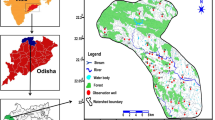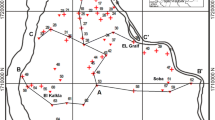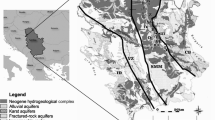Abstract
The area lies between Hugli river in the northwest and Bidyadhari river in the east and includes the East Kolkata Wetlands. The East Kolkata Wetlands is included in the List of Wetlands of International Importance (“Ramsar List”), as per the Convention on Wetlands signed in Ramsar, Iran, in 1971. This wetland has been declared as a Ramsar site on the 19th August 2002 (Ramsar site no. 1208) and therefore has acquired an international status. The area is a part of the lower deltaic plain of the Bhagirathi–Ganga river system and is generally flat in nature. The sub-surface geology of the area is completely blanketed by the Quaternary fluviatile sediments comprising a succession of clay, silty clay, sand and sand mixed with occasional gravel. The Quaternary aquifer is sandwiched between two clay sequences. The confined aquifer is made up of moderately well sorted sand and reflects fluviatile environment of deposition. The regional groundwater flow direction is from east to west. Detailed geochemical investigations of 40 groundwater samples along with statistical analysis (for example, correlation and principal component analysis) on these chemical data reveal: (i) four types of groundwater quality, for example, good, poor, very poor and water unsuitable for drinking purpose, (ii) four hydrochemical facies which may be assigned to three broad types such as “fresh”, “blended”, and “brackish” waters, (iii) the evolution of the “blended” water is possibly due to hydraulic mixing of “fresh” and “brackish” waters within the aquifer matrix and/or in well mixing, and (iv) absence of Na–Cl facies indicates continuous flushing of the aquifer.









Similar content being viewed by others
References
APHA (American Public Health Association) (1985) Standard methods for the examination of water and waste water, 16th edn. APHA, AWWA, WPCF
Back W (1960) Origin of hydrochemical facies of groundwater in the Atlantic Coastal Plain. In: 22nd International Geological Congress, Copenhagen, pp 87–95
Banerjee M, Sen PK, Dastidar AG (1984) On the depositional condition of the Holocene sediments of Bengal basin with remarks on environmental condition of the soft grey clay deposition in Calcutta. Indian Geotech Conf 84(1):63–69
Barui NC, Chanda S (1992) Late Quaternary pollen analysis in relation to palaeoecology, biostratigraphy and dating of Calcutta peat. Indian Natl Sci Acad 58B(4):191–200
BIS (Bureau of Indian Standards) 10500 (1991) Indian Standard drinking water-specification. First revision, pp 1–8
Chaterji GC, Deshmukh DS, Sinha SC, Niyogi BN (1959) Some recent observations on the depth of sediment in the Ganga valley below Varanasi. Ganga Valley: a symposium. ONGC, Dehra Dun
Davis JC (1973) Statistics and data analysis in geology. Wiley, New York
Hait AK, Das HK, Chakrabarty S, Ray AK, Chanda S (1994a) Late Quaternary Palaeontological changes in coastal Digha: a note based on floral and faunal record. Indian J Earth Sci 16(2):192–198
Hait AK, Das HK, Ghosh S, Ray AK, Chanda S (1994b) On the occurrence of Mangrove biota and some faunal remains from the sediments of Haldia: West Bengal in relation to its past environment. J Palynol 30:73–78
Hait AK, Das HK, Ghosh S, Ray AK, Chanda S (1996) Environmental variations in Late Quaternary sequence of Kolaghat, West Bengal, India. Curr Sci 70(12):1089–1093
Harman HH (1967) Modern factor analysis. 2nd edn. University of Chicago Press, Chicago
Mishra PC, Patel RK (2001) Study of the pollution load in the drinking water of Rairangpur, a small tribal dominated town of North Orissa. Indian J Environ Ecoplan 5(2):293–298
Naik S, Purohit KM (2001) Studies on water quality of river Brahmani in Sundargarh district, Orissa. Indian J Environ Ecoplan 5(2):397–402
Ophori DU, Toth J (1989) Patterns of groundwater chemistry, Ross Creek Basin, Alberta, Canada. Groundwater 27(1):20–26
Piper AM (1944) A graphic procedure in the geochemical interpretation of water analysis. Am Geophys Union Trans 25:914–923
Sen PK, Banerjee M (1990) Palynoplankton stratigraphy and environmental changes during Holocene in Bengal basin, India. Rec Palaeobot Palynol 62:25–35
Sikdar PK (2000) Geology of the Quaternary Aquifers of the Twin City of Calcutta–Howrah. J Geol Soc India 56:169–181
Sikdar PK, Sarkar SS, Dasgupta S (1993) Compositional structure of groundwater in and around Gangajalhati, Bankura district,West Bengal. Indian J Earth Sci 20(1):17–27
Sikdar PK, Bhattacharya P (1999) Geochemistry of groundwater of Jhalda–II Block, Purulia district, West Bengal. J Appl Hydrol XII(2):10–22
Sikdar PK, Sarkar SS, Palchoudhury S (2001) Geochemical evolution of groundwater in the Quaternary Aquifers of Calcutta and Howrah, India. J Asian Earth Sci 19:579–594
Sikdar PK, Mondal S, Saha L, Sarkar SS, Banerjee S (2002) Environmental impact assessment of a proposed info-tech complex in East Calcutta wetlands. Environmentalist 22(4):241–260
Singh DF (1992) Studies on the water quality index of some major rivers of Pune, Maharashtra. Proc Acad Environ Biol 1(1):61–66
Subba Rao N (1997) Studies on water quality index in hard rock terrain of Guntur district, Andhra Pradesh, India. National Seminar on Hydrology of Precambrian Terrains and hard rock areas, pp 129–134
Tiwari TN, Mishra MA (1985) A preliminary assignment of water quality index of major Indian rivers. Indian J Environ Proc 5:276–279
Usnoff EJ, Guzman A (1989) Multivariate analysis in hydrochemistry: an example of the use of factor and correspondence analysis. Groundwater 27(1):27–34
WHO (World Health Organization) (1993) Guideline for drinking water quality, 2nd edn, vol 1, p 188
Acknowledgments
The authors convey thanks to Prof. Ashoke K Dutta, Director, Indian Institute of Social Welfare and Business Management for giving permission to publish this paper. The authors also acknowledge the help and encouragement rendered by Professor Swastik Misra, Head, Public Systems Management, Indian Institute of Social Welfare and Business Management, and for the help rendered by Mr. Surajit Chakraborty, JRF in preparation of the maps. The first author is thankful to Council of Scientific and Industrial Research (CSIR), India for their financial assistance.
Author information
Authors and Affiliations
Corresponding author
Rights and permissions
About this article
Cite this article
Sahu, P., Sikdar, P.K. Hydrochemical framework of the aquifer in and around East Kolkata Wetlands, West Bengal, India. Environ Geol 55, 823–835 (2008). https://doi.org/10.1007/s00254-007-1034-x
Received:
Accepted:
Published:
Issue Date:
DOI: https://doi.org/10.1007/s00254-007-1034-x




